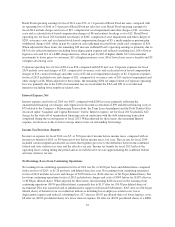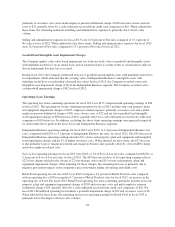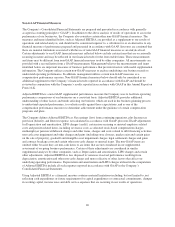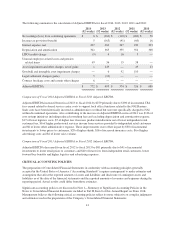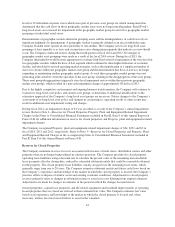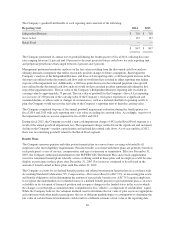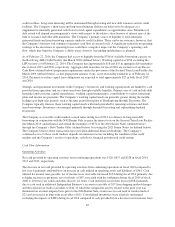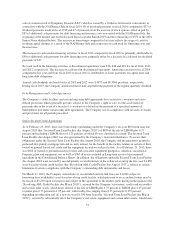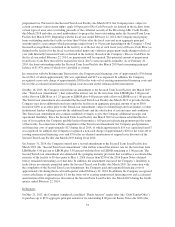Albertsons 2014 Annual Report Download - page 45
Download and view the complete annual report
Please find page 45 of the 2014 Albertsons annual report below. You can navigate through the pages in the report by either clicking on the pages listed below, or by using the keyword search tool below to find specific information within the annual report.The Company uses one of either cost, weighted average cost, RIM or replacement cost to value certain discrete
inventory items under the first-in, first-out method (“FIFO”). The replacement cost approach under the FIFO
method is predominantly utilized in determining the value of high turnover perishable items, including produce,
deli, bakery, meat and floral.
As of February 22, 2014 and February 23, 2013, approximately 25 percent and 23 percent, respectively, of the
Company’s inventories were valued using the cost, weighted average cost and RIM methods under the FIFO
method of inventory accounting. The remaining 18 percent and 17 percent of the Company’s inventories as of
February 22, 2014 and February 23, 2013, respectively, were valued using the replacement cost approach under
the FIFO method of inventory accounting. The replacement cost approach applied under the FIFO method results
in inventories recorded at the lower of cost or market because of the very high inventory turnover and the
resulting low inventory days supply for these items of inventory.
During fiscal 2014, 2013 and 2012, inventory quantities in certain LIFO layers were reduced. These reductions
resulted in a liquidation of LIFO inventory quantities carried at lower costs prevailing in prior years as compared
with the cost of fiscal 2014, 2013 and 2012 purchases. As a result, Cost of sales decreased by $14, $6 and $9 in
fiscal 2014, 2013 and 2012, respectively. If the FIFO method had been used to determine cost of inventories for
which the LIFO method is used, the Company’s inventories would have been higher by approximately $202 and
$211 as of February 22, 2014 and February 23, 2013, respectively.
The Company evaluates inventory shortages throughout each fiscal year based on actual physical counts in its
facilities. Allowances for inventory shortages are recorded based on the results of these counts to provide for
estimated shortages as of the end of each fiscal year.
Long-Lived Assets
The Company monitors the recoverability of its long-lived assets such as buildings and equipment, and tests for
impairment whenever events or changes in circumstances indicate that the carrying amount of such assets may
not be fully recoverable. Events and circumstances that could prompt the Company to perform a recoverability
test include current period losses combined with a history of losses or a projection of continuing losses, a
significant decrease in the market value of an asset or the Company’s plans for store closures.
A recoverability test is performed by comparing projected undiscounted future cash flows to the carrying value
of the group of assets being tested.
If impairment is identified for long-lived assets to be held and used, the fair value is compared to the carrying
value of the group of assets and an impairment charge is recorded for the excess of the carrying value over the
fair value. For long-lived assets that are classified as assets held for sale, the Company recognizes impairment
charges for the excess of the carrying value plus estimated costs of disposal over the estimated fair value. Fair
value is based on current market values or discounted future cash flows using Level 3 inputs. The Company
estimates fair value based on the Company’s experience and knowledge of the market in which the property is
located and, when necessary, utilizes local real estate brokers. The Company’s estimate of undiscounted cash
flows attributable to the asset groups includes only future cash flows that are directly associated with and that are
expected to arise as a direct result of the use and eventual disposition of the asset group. Long-lived asset
impairment charges are a component of Selling and administrative expenses in the Consolidated Statements of
Operations.
The Company groups long-lived assets with other assets at the lowest level for which identifiable cash flows are
largely independent of the cash flows of other assets, which historically has predominantly been at the
geographic market level, but the individual store asset groupings have been assessed in certain circumstances.
Independent Business’s long-lived assets are reviewed for impairment at the distribution center level. Save-A-
Lot’s long-lived assets are reviewed for impairment at the geographic market level for 11 geographic market
groupings of corporate-operated stores and related dedicated distribution centers, and individual corporate store
43




